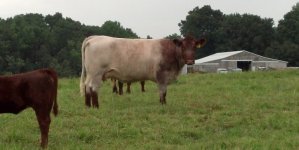KFShorthorns
Well-known member
Interesting 'purity' conversation no doubt. As a relative new comer to the purebred side of shorthorns it's always interesting to see how these conversations play out and to piece together history and some of what has gone on in different associations. I was recently given Volume 1 of the Dominion Shorthorn Herdbook, published in 1886. It details the first importations of purebred shorthorns to Canada in 1825, with some detail of US imports before that. There is an entire chapter describing the struggles that the American and Canadian (British-American or Dominion) associations had with defining 'purebred', in the early 1800's. Originally only imported British cattle (of Coates HB) and their offspring were allowed in the american herd book, but then for a couple years they allowed any cattle that had been crossed 4 times with pure, imported british stock to be registered as purebred. This was disallowed a few years later, but the crossed catttle were never removed from the american herdbook. With the first print of the Dominion of Canada herdbook there was discussion of these cattle and their progeny, that had now made their way into Canada, and decided that they would not be included in the herdbook because they did not trace completely back to imported british stock. In the first editions of the Canadian Shorthorn herdbook, in the 1860's (prior to the Dominion Shorthorn book I have of 1886) it would appear 14 'grade' canadian bred shorthorn cows were registered as pure, these cows and there offspring were exluded from the Dominion Shorthorn book printed in 1886. I do not know of which book (Canada or Dominion) our current association registry was built, though I'd be interested to find out! JIT? Okotoks? Coyote? any of you guys able to fill in some of that?
Things have obviously changed in the association's since then, with the asterisk cattle and grading up and allowing non-pedigree cattle inat various times, but by the statements made in the 1880's it would seem to me that alot of cattle that may appear 'purebred' by the american association very well could trace back to these cattle that were allowed in the registry in the early 1800's that WERE NOT indeed purebreds.
More food for thought anyway, the debate rages on.
Cheers <beer>
Things have obviously changed in the association's since then, with the asterisk cattle and grading up and allowing non-pedigree cattle inat various times, but by the statements made in the 1880's it would seem to me that alot of cattle that may appear 'purebred' by the american association very well could trace back to these cattle that were allowed in the registry in the early 1800's that WERE NOT indeed purebreds.
More food for thought anyway, the debate rages on.
Cheers <beer>

